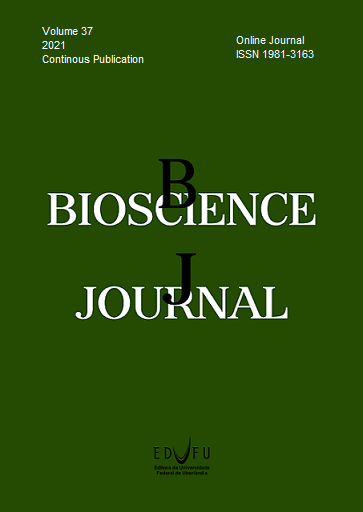Acute effect of different orders of concurrent training on glycemia
DOI:
https://doi.org/10.14393/BJ-v37n0a2021-49851Keywords:
Aerobic training, Blood glucose, Exercise, Resistance training.Abstract
The present study verified the effect of a concurrent training (CT) session in different orders, Strength + Endurance (SE) and Endurance + Strength (ES), on the glycemic control. The crossover study included 20 young men, 21.80 ± 2.90 years, IMC ≥ 23 kg/m2, 24.83 ± 3.68% of fat, who performed both CT sessions separated by 72 h. Capillary glycemia was measured at pre, immediately post the end of each exercise session, and during the recovery period at 30, 60, and 90 minutes. The comparisons were performed using Two-way ANOVA (order and time), paired test-t for the area under the curve, as well as Cohen’s d effect size. There was effect of exercise order (F = 5.973; p = 0.03), effect of time (F = 18.345; p = 0.001) and interaction between order and time (F = 2.835; p = 0.03). The area under the curve presented a significant reduction (p = 0.03, effect size = 0.51, moderate). The area under the curve was smaller in SE, as well as glucose concentrations at end and post 30 min of exercise, suggesting better efficiency in glycemic control compared to ES.
References
BACCHI, E., et al. Differences in the acute effects of aerobic and resistance exercise in subjects with type 2 diabetes: results from the RAED2 Randomized Trial. Plos One. 2012, 7(12), e49937. https://doi.org/10.1371/journal.pone.0049937
BELL, G.J., et al. Effect of concurrent strength and endurance training on skeletal muscle properties and hormone concentrations in humans. European Journal of Applied Physiology. 2000, 81(5), 418-427. https://doi.org/10.1007/s004210050063
BROWN, L.E. and WEIR, J.P. ASEP - Procedures recommendation I: accurate assessment of muscular strength and power. Journal of Exercise Physiology Online. 2001, 4(1), 1-21.
CARVALHEIRA, J.B.C., and SAAD, M.J.A. Doenças associadas à resistência à insulina/hiperinsulinemia, não incluídas na síndrome metabólica. Arquivos Brasileiros de Endocrinologia & Metabologia, 50(2), 360-367.
https://doi.org/10.1590/S0004-27302006000200022
CHUNG, J.O., et al. Associations among body mass index, insulin resistance, and pancreatic β-cell function in Korean patients with new-onset type 2 diabetes. The Korean Journal of Internal Medicine. 2012, 27(1), 66-71. https://doi.org/10.3904/kjim.2012.27.1.66
COHEN, J. Statistical Power Analysis for Behavioral Sciences. 2nd ed. London: Routledge, 1988.
DOLEZAL, B.A. and POTTEIGER, J.A. Concurrent resistance and endurance training influence basal metabolic rate in nondieting individuals. European Journal of Applied Physiology. 1998, 85(2), 695-700. https://doi.org/10.1152/jappl.1998.85.2.695
FYFE, J.J., BISHOP, D.J. and STEPTO, N.K. Interference between concurrent resistance and endurance exercise: molecular bases and the role of individual training variables. Sports Medicine. 2014, 44(6), 743-762. https://doi.org/10.1007/s40279-014-0162-1
GUEDES, D.P. Composição corporal: princípios, técnicas e aplicações. 2nd ed. Londrina: APEF, 1994.
JAMES, P. and MCFADDEN, R. Understanding the processes behind the regulation of blood glucose. Nursing Times. 2004, 100(16), 56-58.
KING, F., et al. A review of blood glucose monitor accuracy. Diabetes Technology & Therapeutics. 2018, 20(12), 843-853, 2018. https://doi.org/10.1089/dia.2018.0232
LIN, J., and CHEN, T. Diversity of strength training methods: A theoretical approach. Strength and Conditioning Journal. 2012, 34(2), 42-49, 2012. https://doi.org/10.1519/SSC.0b013e31822f73ea
METHENITIS, S. A brief review on concurrent training: from laboratory to the field. Sports (Basel). 2018, 6(4), E127. https://doi.org/10.3390/sports6040127
NASCIMENTO, M.A, et al. Familiarization and reliability of 1RM strength testing in older women. Journal of Strength and Conditioning. 2013, 27(6), 1636-1642. https://doi.org/10.1519/JSC.0b013e3182717318
OGASAWARA, R., et al. The order of concurrent endurance and resistance exercise modifies mTOR signaling and protein synthesis in rat skeletal muscle. American Journal of Physiology-Endocrinology and Metabolism. 2014, 306(10), 1155-1562. https://doi.org/10.1152/ajpendo.00647.2013
OKURA, T., et al. Body mass index ≥23 is a risk factor for insulin resistance and diabetes in Japanese people: A brief report. PLoS One. 2018, 13(7), e0201052, jul. https://doi.org/10.1371/journal.pone.0201052
PAULI, J.R., et al. Acute exercise reverses aged-induced impairments in insulin signaling in rodent skeletal muscle. Mechanisms of Ageing and Development. 2010, 131(5), 323-329. https://doi.org/10.1016/j.mad.2010.03.004
PEREIRA, R.M., et al. Molecular mechanisms of glucose uptake in skeletal muscle at rest and in response to exercise. Motriz. 2017, 23, e101609. https://doi.org/10.1590/s1980-6574201700si0004
PESCATELLO, L., et al. ACSM’s Guidelines for Exercise Testing and Prescription. 9 ed. Philadelphia: Wolters Kluer Health/Lippincott Willians & Wilkins, 2014.
RODRIGUES, R.W.P., et al. Efeitos do exercício resistido de alta intensidade em ratos que receberam dexametasona. Revista Brasileira de Medicina do Esporte. 2016, 22(3), 211-215. https://doi.org/10.1590/1517-869220162203148503
RÖHLING, M., et al. Influence of acute and chronic exercise on glucose uptake. Journal of Diabetes Research. 2016, 2016, 2868652. https://doi.org/10.1155/2016/2868652
SHERI, R.C., et al. Physical Activity/Exercise and Diabetes: A Position Statement of the American Diabetes Association. Diabetes Care. 2016, 39(11), 2065-2079. https://doi.org/10.2337/dc16-1728
SYLOW, L., et al. Exercise-stimulated glucose uptake—regulation and implications for glycaemic control. Nature Reviews Endocrinology. 2017, 13(3), 133-148. https://doi.org/10.1038/nrendo.2016.162
VAN DIJK, J.W., et al. Postprandial hyperglycemia is highly prevalent throughout the day in type 2 diabetes patients. Diabetes Research and Clinical Practice. 2011, 93(1), 31-37. https://doi.org/10.1016/j.diabres.2011.03.021
WELTMAN, A., et al. Reliability and validity of a continuous incremental treadmill protocol for the determination of lactate threshold, fixed blood lactate concentrations, and VO2max. International Journal of Sports Medicine. 1990, 11(1), 26-32. https://doi.org/10.1055/s-2007-1024757
Downloads
Published
Issue
Section
License
Copyright (c) 2021 Osvaldo Tadeu da Silva Junior, Gustavo Marinho do Nascimento, Giovane Henrique da Silva Nishioka, Anderson Polesel Batista, Jose Alexandre Curiacos , Julio Wilson dos Santos

This work is licensed under a Creative Commons Attribution 4.0 International License.





